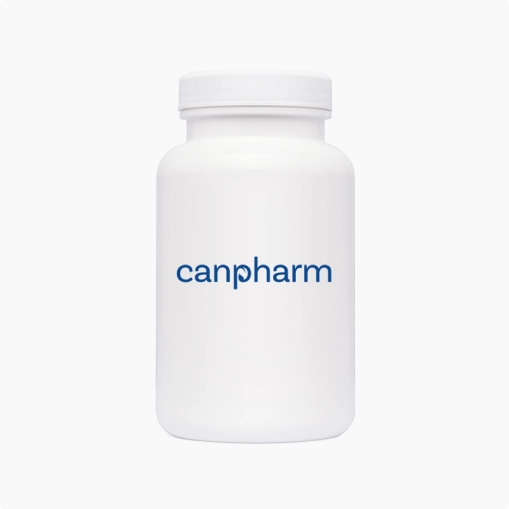
-
Description
-
Reviews (0)
-
Related Products
-
Related Conditions
Fact Table
| Fact Table | |
|---|---|
| Formula | C21H24N4O2S |
| License | US FDA, EU EMA |
| Bioavailability | 29–35% |
| Legal status | Rx-Only |
| Chemical Name | Mirabegron |
| Elimination half-life | 50 hours |
| Dosage (Strength) | 25mg, 50mg |
| Pregnancy | Not recommended |
| Brands | Myrbetriq |
| Protein binding | 71% |
| PubChem CID | 9865528 |
| MedlinePlus | a612038 |
| ChEBI | 65349 |
| ATC code | G04BD12 |
| DrugBank | DB08893 |
| KEGG | D09535 |
| Routes of administration | By mouth (tablets) |
Myrbetriq is a medication that helps relax the muscles of the bladder, which reduces spasms. It is prescribed for adults to alleviate symptoms of overactive bladder. In some cases, it may be used alongside solifenacin. Additionally, Myrbetriq is used in children to treat neurogenic detrusor overactivity (NDO), a condition characterized by urinary incontinence resulting from permanent nerve damage caused by conditions like multiple sclerosis or spinal injury.
When considering treatment options for an Overactive Bladder, it's important to consider factors such as effectiveness, potential side effects, and the Myrbetriq cost.
What is Overactive Bladder (OAB)?
Overactive bladder is a condition characterized by a sudden and frequent urge to urinate. People with this condition may experience urinary urgency, where they feel the need to urinate immediately, often resulting in involuntary urine leakage. Overactive bladder can significantly impact a person's quality of life and may be caused by a range of factors, including bladder muscle overactivity and nerve problems. Treatment options range from lifestyle changes and behavioral therapies to medications and, in some cases, medical procedures.
Directions
Take this medication orally as prescribed by your doctor, typically once a day. Adults can take it with or without food, while children should take it with food. Swallow the medication whole and avoid crushing, chewing, or dividing it, as this can lead to the sudden release of the entire dose, increasing the risk of side effects.
The appropriate dosage will be determined by your doctor based on your specific medical condition and how you respond to the treatment. For children, the dose will also depend on their weight.
To derive the maximum benefit from this medication, use it regularly and take it at the same time each day to help with remembering.
Ingredients
Myrbetriq uses Mirabegron as its active ingredient.
Cautions
Do not take Myrbetriq if you are allergic to mirabegron or any ingredients in it.
Myrbetriq may elevate blood pressure or exacerbate pre-existing hypertension.
Myrbetriq can increase the likelihood of difficulty emptying the bladder. Inform your doctor promptly if you have trouble emptying your bladder or experience a weak urine stream.
Before you buy Myrbetriq, disclose all your medical history to your doctor, including liver or kidney problems.
Myrbetriq granules are indicated for children who are at least 3 years old and weigh a minimum of 77 pounds.
Interactions
This medication could have negative drug interactions with flecainide, propafenone, thioridazine, digoxin, or solifenacin succinate. Let your doctor know about all the prescription, and non-prescription drugs, and herbal products before you start your treatment with Myrbetriq.
Side Effects
Possible side effects of Myrbetriq may include uncomfortable urination, elevated blood pressure, discomfort in the sinuses and throat, bowel irregularity, headaches, dry mouth, or rapid heartbeat.
Frequently Asked Questions about Myrbetriq
What is Myrbetriq Used for?
Myrbetriq is used to treat a condition called overactive bladder (OAB). It helps to relax the muscles in the bladder, reducing the frequent need to urinate, urgent urination, and sudden urinary incontinence (uncontrolled leakage of urine).
How Long Does Myrbetriq Stay in Your System?
The elimination half-life of Myrbetriq is approximately 12 to 14 hours. It typically takes about five half-lives for a medication to be cleared from the body. So, within 60 to 70 hours (2.5 to 3 days), Myrbetriq should be mostly eliminated from your system.
Does Myrbetriq Cause Weight Gain?
Weight gain is not a common side effect associated with Myrbetriq. However, individual responses to medications can vary, and some people may experience weight gain as a side effect.
Who Should Not Take Myrbetriq?
Myrbetriq should not be taken by individuals with severe liver problems, uncontrolled high blood pressure, or certain types of urinary retention.
Do You Have to Take Myrbetriq Forever?
The duration of Myrbetriq treatment can vary depending on individual circumstances. In some cases, Myrbetriq may be prescribed for long-term use to manage symptoms of overactive bladder. Studies have shown that it takes a minimum of four weeks of taking Myrbetriq daily to start seeing effects, with improvements in symptoms being seen within 4-12 weeks.
Why is Myrbetriq so Expensive?
The cost of Myrbetriq can be influenced by factors such as research and development costs, manufacturing expenses, and market demand. Generic Myrbetriq is a cheaper option for many. If you want to buy Generic Mybetriq online, you can get the best price on Canpharm. You can also achieve substantial cost savings by choosing Xifaxan generic available on Canpharm.
Does Myrbetriq Make You Pee More?
Myrbetriq is designed to reduce the frequency of urination and urgent urination associated with an overactive bladder. While it may not necessarily make you urinate more, it can help with better bladder control by reducing the sudden and uncontrollable need to urinate.
Should Myrbetriq be Taken Morning or Night?
The timing of Myrbetriq intake can be determined based on personal preference. It is commonly recommended to take Myrbetriq once daily, either in the morning or at night.
